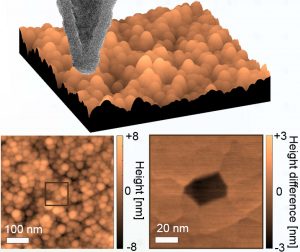
An atomic force microscope probe (top) is used to measure the shape of a nanoparticle packing before (left) and after an indentation experiment is performed. After the experiment, performed in the boxed region, only one particle (right) is seen to be perturbed.
J. A. Lefever, T. D. B. Jacobs, Q. Tam, J. L. Hor, Y.-R. Huang, D. Lee, & R. W. Carpick
At the smallest length scales, disordered systems such as nanoparticle packings and glass resemble the grains of sand on a beach. Lacking a structure, it is very difficult to understand how they deform and flow. We use a technique called atomic force microscopy, in which a sharp probe “feels” and pokes at a sample to measure its shape and mechanical properties. We are able to investigate at the length scale of a single particle.
We find that different locations in the film feature variations in mechanical properties, that is, there are strong and weak spots. These weak spots are likely the regions where fractures begin. This provides a tool for investigating and tailoring the fracture strength, which is useful for making more durable materials such as cell phone screens.
Lefever et al, Nano Lett. 16, 2455-2462 (2016).
